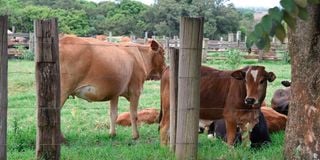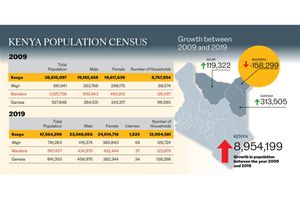The tough decision of culling dairy cows

Cows at a homestead in Uasin Gishu County. Voluntary culling helps the farm optimise profits but involuntary in most cases causes losses.
What you need to know:
- While we may want to avoid propagation of undesirable traits, it is important to apply cost-benefit analysis to save the farmer from avoidable losses directly or indirectly.
Culling is a term used in dairy farming to describe the removal of cattle from the herd by slaughter, sale or death.
Voluntary culling is the removal of animals from the herd to maintain the desired stock numbers or as a business strategy.
In such culling, the animals are in good state of health, production and reproduction. They are mainly bought from the farm by people who wish to keep them for production and reproduction.
Involuntary culling is the removal of animals from the herd due to undesired developments like disease, poor genetics and poor production and reproduction.
Voluntary culling helps the farm optimise profits but involuntary in most cases causes some losses. When an animal, for instance, gets mastitis or loses teats, the farmer may sell it at much lower than its market price.
Second, the farmer incurs opportunity cost because she may not have recouped the cost of rearing the animal up to the point of culling.
Voluntary culling is beneficial to the farmer as it is planned. A farmer, for instance, may decide to be culling heifers at a specified pregnancy age to remove surplus stock or do away with milkers if their production attains the minimum yield for the farm.
In both cases, the culls would be useful as stock to other farmers with suitable production standards.
The question, however, arises on whether to cull or not in involuntary culling. The farmer must decide that the situation of the affected cow cannot be stopped and the animal restored to its preferred state.
Involuntary culling, therefore, is a decision of the farmer, often with advice from a veterinary doctor or animal health service provider.
Last week, I narrated the cases of cattle with bovine rolling tongue orosthenic syndrome (BRTOS). Some readers asked why the long name of the behaviour while it appeared like the affected cows just roll their tongues.
The explanation is that the name specifies that affected animals are cattle, scientifically called bovine.
Oro in Latin means “relating to the mouth” while sthenic means “excessively vigorous”. Therefore, it is a behaviour of cattle rolling their tongues and other mouth tissues in a repetitive vigorous manner.
Syndrome means there are other observations made on the affected animals such as poor body condition, salivation and anxiety.
After reading the article, some farmers sent me videos of their cattle exhibiting BRTOS and said they were happy to understand the cows had a behavioural problem and not sickness.
All wondered if they should cull the cattle.
I had, in my article, advised farmers not to breed cattle with BRTOS in order to prevent propagation of the behaviour.
I advised the farmers to keep the animals but work to discourage entrenchment of the behaviour.
I established the farmers were small scale and their cattle were good quality Jersey mixes. Most of the animals were pregnant.
My advise was based on the fact that the farmers only had a few animals.
They were, therefore, unlikely to produce large number of animals with the BRTOS trait. Second, the animals were pregnant, and mainly heifers.
The farmers had, therefore, invested a lot in rearing the heifers to pregnant stage. Selling off the animals would not be economical.
Further, the BRTOS behaviour can be discouraged by methods such as providing salt blocks, whole fodder and increasing the living space to lower the feeling of confinement by the animal.
While we may want to avoid propagation of certain undesirable traits, it is also important to apply cost-benefit analysis to save the farmer from avoidable losses directly or indirectly through opportunity cost.
Reasons for culling animals on a dairy farm should always be well documented and reviewed regularly to establish if some are due to management deficiencies.
For instance, if mastitis, reproduction or production are the most common causes of culling, the farmer should be assisted to find out which management shortcomings are contributing to the occurrence of the culling reasons.
Mastitis could most likely be due to bad farm hygiene and poor education of the farm employees.
Instituting corrective measures on hygiene, worker education, reproduction management and nutrition of the animals would reduce the rate of culling due to poor reproduction and production performance of the cows.
Last week, I visited a farm in Murang’a where the owner wanted me to advise her which cows to cull because of recurrent lameness.
Fortunately for the farmer, the animals’ feet were not irreparably damaged.
I treated the five animals and advised the farmer to repair the shed floor.
I noticed the floor had pebbles jutting above the surface in areas the sand-cement mixture had worn out.
The pebbles exerted very high pressure on the soles of the hooves, thereby causing injury. This led to bacterial infection of the feet and lameness.
The farmer had also complained that the hips of the lame cattle were twisted and the backs sunken. The animals had lost weight and production.
I explained that the cattle were greatly stressed by the pebbles and uneven floor.
The poor cows were trying to hold their weight to remain on the upper body and the hips to reduce pressure on their feet.
The solution was not to cull the cows but to repair the floor and feed the cattle properly.
Even if the farmer culled the animals, others would follow suit if the floor remained in the same state.





